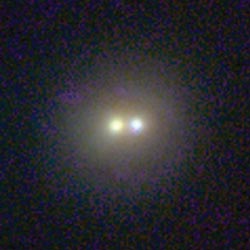Richard Gaughan, Contributing Editor
The dynamic interaction of galaxies is believed to play a fundamental role in stellar evolution. The compression created in interstellar gas as two galaxies collide can cause shock waves that trigger the formation of stars composed of a different set of constituent atoms. A laboratory experiment to test this hypothesis obviously is out of the question, so astronomers must use the universe as their laboratory. Colliding galaxies are not that easy to come by, however, and some of great interest are so far away that they are very difficult to image.
A new adaptive optics capability at the W.M. Keck Observatory on Mauna Kea in Hawaii is addressing the imaging problem. At the American Astronomical Society meeting in San Diego in January, astronomers from the Santa Cruz and Los Angeles campuses of the University of California and from the observatory reported the results of their tests of the adaptive optics system on the 10-m Keck II telescope. Their first scientific-quality images reveal details of colliding galaxies some 5 billion light-years away.

Adaptive optics technology at the W.M. Keck Observatory is enabling astronomers to test hypotheses that predict galactic collisions result in stellar formation. This galaxy contains two nuclei, suggesting a relatively recent collision. The three-color image combines a visible-wavelength image taken using the Hubble Space Telescope and mid-IR images from the 10-m Keck II telescope.
Adaptive optics is the generic term for wavefront-correction technologies that compensate for variable aberration. In astronomy, most of that aberration is the result of changes in the refractive index profile of the atmosphere between the object under observation and the telescope aperture. The temperature and density of the air in the light path change rapidly, so an adaptive optics system for astronomy must actively sense the aberrations and correct for them by rapidly deforming the telescope’s mirror.
To do so, the systems detect the dynamic effects of the atmosphere on a perfect wavefront so they have a target toward which to drive the wavefront corrector. A bright star in the sky near the object of interest can act as a point source to help accomplish this, but relying on such natural guide stars limits observation to those objects near them. Moreover, a nearby bright star can actually provide too much background light for the imaging of distant galaxies.
The solution is to build an artificial guide star. At Keck, a dye laser excites sodium atoms in a thin layer of the atmosphere approximately 90 km above the Earth’s surface. Because the excitation is localized, it provides a good point source. And because it is high in the sky, it reveals aberrations through most of the optical path.
The Keck images, taken in the mid-infrared region, combined with visible images taken by the Hubble Space Telescope, provide some insight into galactic interactions. One galaxy that appears to be the result of a recent collision still shows two distinct cores but does not show evidence of star formation. The astronomers suggest that it could be the result of a so-called dry merger, involving two galaxies with relatively little interstellar gas.
Another galaxy in the same image field also appears to be the result of a recent collision and shows evidence of star formation, but it is highly disordered.